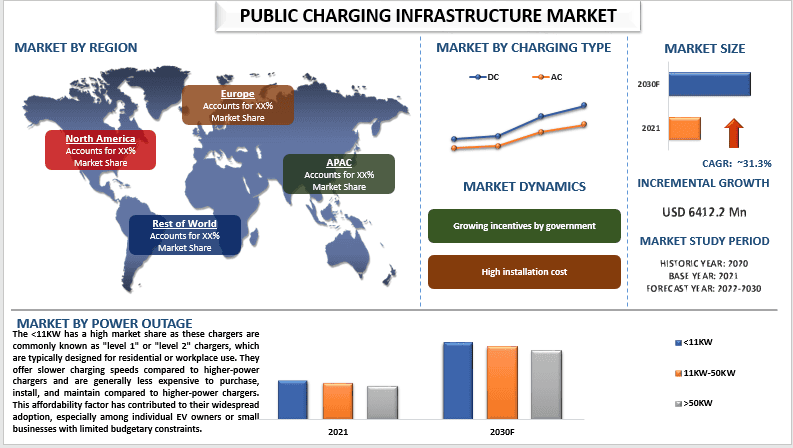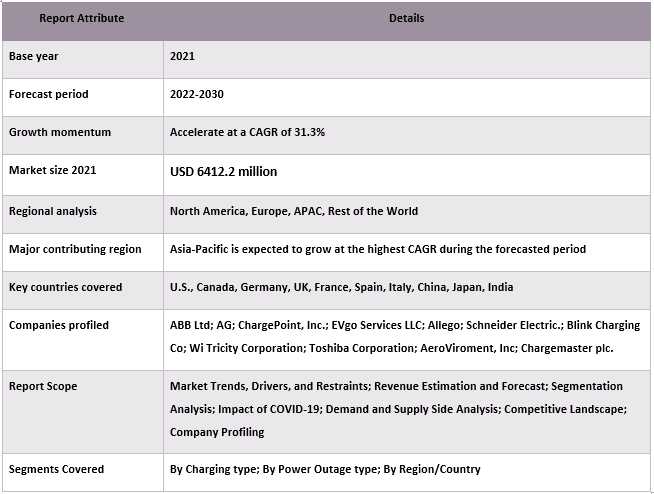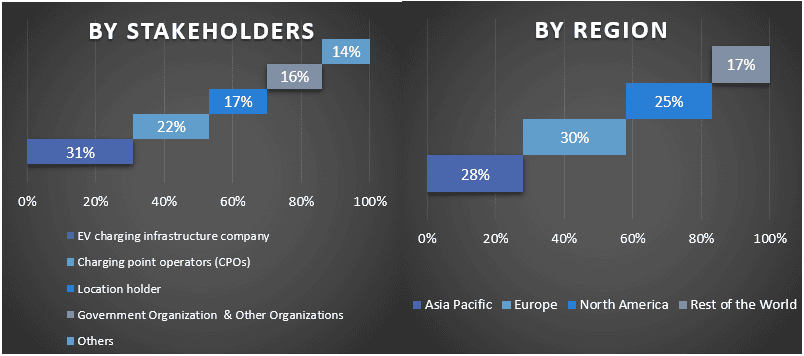- Home
- About Us
- Industry
- Services
- Reading
- Contact Us
Public Charging Infrastructure Market – Global Industry Analysis, Size, Share, Growth & Forecast (2022-2030)
Emphasis on Charging Type (DC and AC); Power Outage (<11KW, 11KW-50KW, and >50KW]; and Region/Country

The public charging infrastructure market was valued at US$ 6412.2 Million in year 2021 and is expected to grow at a strong CAGR of around 31.3% during the forecast period (2022-2030) owing to the growing vehicle sales. Automotive wheel alignments are a crucial aspect of vehicle maintenance that involves adjusting the angles of the wheels to ensure they are perpendicular to the ground and parallel to each other. In addition, proper wheel alignment is essential for vehicle safety, tire performance, and fuel efficiency. Moreover, the use of advanced technologies such as 3D imaging and laser-guided wheel alignment system, high demand for used vehicles, and growing awareness of vehicle maintenance are the factors driving the growth of the market.
Some of the major players operating in the market include ABB Ltd; AG; ChargePoint, Inc.; EVgo Services LLC; Allego; Schneider Electric.; Blink Charging Co; Wi Tricity Corporation; Toshiba Corporation; AeroViroment, Inc; Chargemaster plc. Several M&As along with partnerships have been undertaken by these players to facilitate customers with hi-tech and innovative products/technologies.
Insights Presented in the Report
“Amongst charging type, the DC segment will also attain a considerable share of the market during the forecast period.”
Based on charging type, the DC segment will also attain a considerable share of the market during the forecast period. The growth of DC EV chargers can be attributed to several factors that are driving their increasing demand and widespread adoption. One significant factor is the need for faster charging times and DC chargers offer significantly faster charging speeds, making them ideal for on-the-go charging and reducing overall charging time. For instance, long-distance travel often requires quick recharging stops, and DC chargers, also known as fast chargers, can replenish an EV’s battery much more rapidly compared to AC chargers. This capability is particularly crucial in enabling long-distance travel for electric vehicle owners, providing them with the confidence that they can conveniently recharge their vehicles during extended journeys. The market’s key players are launching DC fast Chargers which is driving the growth of the market. For instance, In 2023, Evocharge Launches DC Fast Charger Product Line To Serve A Full Range Of Electric Vehicle Markets Across North America.
“Amongst power outage, the >50KW held a considerable share of the market in 2021.”
As electric vehicle fleets continue to grow, businesses, municipalities, and charging operators are investing in high-capacity charging infrastructure to meet the demands of EV users. For instance, highway rest areas, shopping malls, and parking facilities are increasingly equipped with fast-charging stations capable of charging multiple vehicles simultaneously. The increasing prominence of electric buses is another driving force behind the growth of chargers with capacities over 50 kW. With the electrification of public transportation, charging infrastructure needs to accommodate the charging requirements of large-capacity electric buses. High-capacity chargers are essential in ensuring quick turnaround times for buses, allowing them to remain operational throughout the day without lengthy charging delays.
“Europe holds the second largest share of the public charging infrastructure market in 2021.”
The public charging infrastructure services market in Europe holds the second-largest share globally. One of the main factors is the European Union’s (EU) push towards reducing greenhouse gas emissions and meeting climate change targets. As a result, many European countries have implemented policies to incentivize the use of EVs, such as tax breaks, subsidies, and free charging stations. For instance, in Norway, electric cars are exempt from the heavy taxes imposed on gasoline and diesel vehicles, making them more affordable than traditional cars. Moreover, the growing adoption of EV batteries in Europe is the increase in charging infrastructure. In recent years, the number of charging stations across Europe has increased significantly, making it easier for EV owners to recharge their vehicles. For example, the Netherlands has one of the densest charging networks in the world, with over 60,000 charging points available.
Public Charging Infrastructure Market Report Coverage
Reasons to buy this report:
- The study includes market sizing and forecasting analysis validated by authenticated key industry experts.
- The report presents a quick review of overall industry performance at one glance.
- The report covers an in-depth analysis of prominent industry peers with a primary focus on key business financials, product portfolios, expansion strategies, and recent developments.
- Detailed examination of drivers, restraints, key trends, and opportunities prevailing in the industry.
- The study comprehensively covers the market across different segments.
- Deep dive regional level analysis of the industry.
Customization Options:
The global public charging infrastructure market can further be customized as per the requirement or any other market segment. Besides this, UMI understands that you may have your own business needs, hence feel free to contact us to get a report that completely suits your requirements.
Table of Content
Research Methodology for the Public Charging Infrastructure Market Analysis (2022-2030)
Analyzing the historical market, estimating the current market, and forecasting the future market of the global public charging infrastructure market were the three major steps undertaken to create and analyze the adoption of public charging infrastructure in major regions globally. Exhaustive secondary research was conducted to collect the historical market numbers and estimate the current market size. Secondly, to validate these insights, numerous findings and assumptions were taken into consideration. Moreover, exhaustive primary interviews were also conducted, with industry experts across the value chain of the global public charging infrastructure market. Post assumption and validation of market numbers through primary interviews, we employed a top-down/bottom-up approach to forecasting the complete market size. Thereafter, market breakdown and data triangulation methods were adopted to estimate and analyze the market size of segments and sub-segments of the industry pertains to. Detailed methodology is explained below:
Analysis of Historical Market Size
Step 1: In-Depth Study of Secondary Sources:
Detail secondary study was conducted to obtain the historical market size of the public charging infrastructure market through company internal sources such as annual reports & financial statements, performance presentations, press releases, etc., and external sources including journals, news & articles, government publications, competitor publications, sector reports, third-party database, and other credible publications.
Step 2: Market Segmentation:
After obtaining the historical market size of the public charging infrastructure market, we conducted a detailed secondary analysis to gather historical market insights and share for different segments & sub-segments for major regions. Major segments are included in the report as by charging type and power outage. Further country-level analyses were conducted to evaluate the overall adoption of testing models in that region.
Step 3: Factor Analysis:
After acquiring the historical market size of different segments and sub-segments, we conducted a detailed factor analysis to estimate the current market size of the public charging infrastructure market. Further, we conducted factor analysis using dependent and independent variables such as charging type and power outage of the public charging infrastructure market. A thorough analysis was conducted of demand and supply-side scenarios considering top partnerships, mergers and acquisitions, business expansion, and product launches in the public charging infrastructure market sector across the globe.
Current Market Size Estimate & Forecast
Current Market Sizing: Based on actionable insights from the above 3 steps, we arrived at the current market size, key players in the global public charging infrastructure market, and market shares of the segments. All the required percentage shares split, and market breakdowns were determined using the above-mentioned secondary approach and were verified through primary interviews.
Estimation & Forecasting: For market estimation and forecast, weights were assigned to different factors including drivers & trends, restraints, and opportunities available for the stakeholders. After analyzing these factors, relevant forecasting techniques i.e., the top-down/bottom-up approach were applied to arrive at the market forecast for 2028 for different segments and sub-segments across the major markets globally. The research methodology adopted to estimate the market size encompasses:
- The industry’s market size, in terms of revenue (USD) and the adoption rate of the public charging infrastructure market across the major markets domestically
- All percentage shares, splits, and breakdowns of market segments and sub-segments
- Key players in the global public charging infrastructure market in terms of products offered. Also, the growth strategies adopted by these players to compete in the fast-growing market
Market Size and Share Validation
Primary Research: In-depth interviews were conducted with the Key Opinion Leaders (KOLs) including Top Level Executives (CXO/VPs, Sales Head, Marketing Head, Operational Head, Regional Head, Country Head, etc.) across major regions. Primary research findings were then summarized, and statistical analysis was performed to prove the stated hypothesis. Inputs from primary research were consolidated with secondary findings, hence turning information into actionable insights.
Split of Primary Participants in Different Regions

Market Engineering
The data triangulation technique was employed to complete the overall market estimation and to arrive at precise statistical numbers for each segment and sub-segment of the global public charging infrastructure market. data was split into several segments & sub-segments post studying various parameters and trends in the areas of the vehicle type, product type and service providers in the global public charging infrastructure market.
The main objective of the Global Public Charging Infrastructure Market Study
The current & future market trends of the global public charging infrastructure market were pinpointed in the study. Investors can gain strategic insights to base their discretion for investments on the qualitative and quantitative analysis performed in the study. Current and future market trends determined the overall attractiveness of the market at a regional level, providing a platform for the industrial participant to exploit the untapped market to benefit from a first-mover advantage. Other quantitative goals of the studies include:
- Analyze the current and forecast market size of the public charging infrastructure market in terms of value (USD). Also, analyze the current and forecast market size of different segments and sub-segments.
- Segments in the study include areas of the charging type and power outage.
- Define and analysis of the regulatory framework for the public charging infrastructure industry.
- Analyze the value chain involved with the presence of various intermediaries, along with analyzing customer and competitor behaviors of the industry.
- Analyze the current and forecast market size of the public charging infrastructure market for the major region.
- Major countries of regions studied in the report include Asia Pacific, Europe, North America, and the Rest of the World
- Company profiles of the public charging infrastructure market and the growth strategies adopted by the market players to sustain in the fast-growing market.
- Deep dive regional level analysis of the industry
Related Reports
Customers who bought this item also bought










